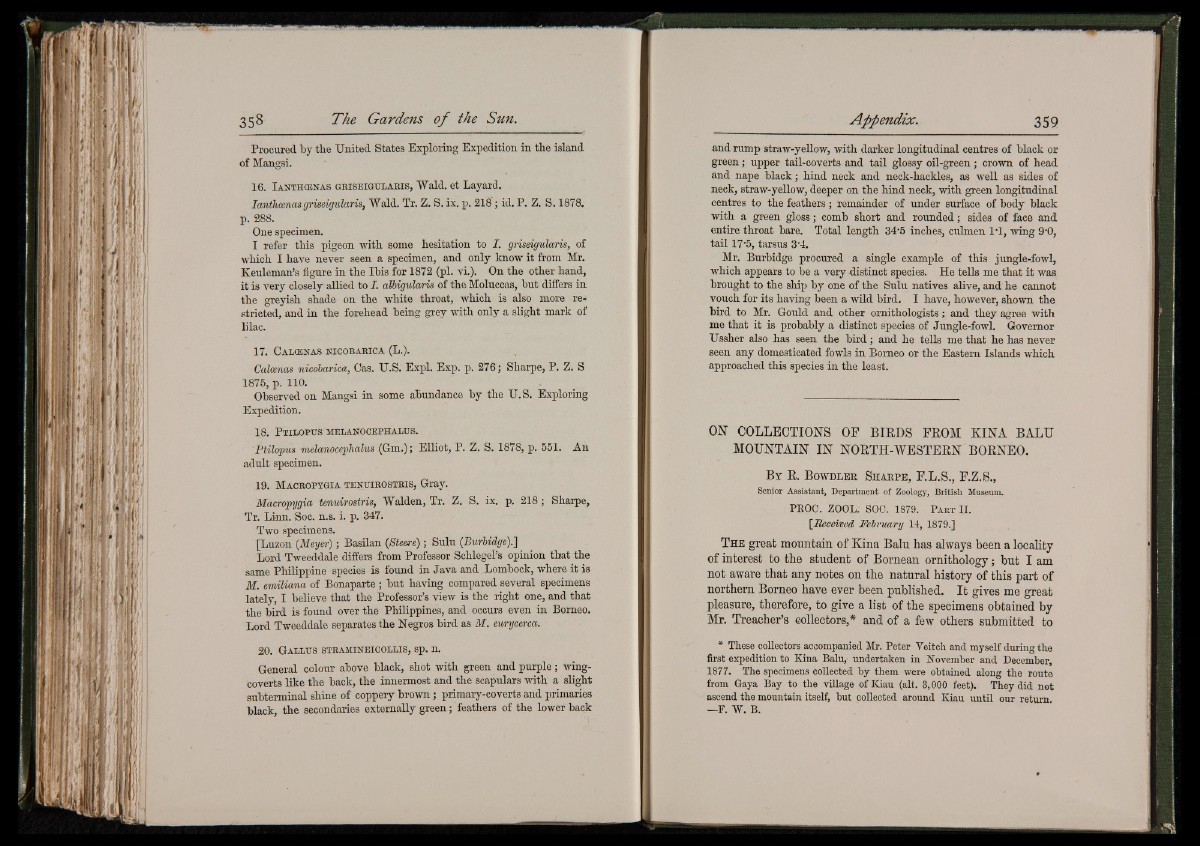
Procured by the United States Exploring Expedition in the island
of Mangsi.
16. I a n t h (ENAs g r is e ig u l a r is , Wald, e t Layard.
lanthcenasgriseigularis, Wald. Tr. Z. S. ix. p. 218; id. P. Z. S. 1878.
p. 288.
One specimen.
I refer this pigeon with some hesitation to I. griseigularis, of
which I have never seen a specimen, and only know it from Mr.
Keuleman’s figure in the Ibis for 1872 (pi. vi.). On the other hand,
it is very closely allied to J. albigularis of the Moluccas, but differs in
the greyish shade on the white throat, which is also more restricted,
and in the forehead being grey with only a slight mark of
lilac.
17. C alcenas n ico ba r ica (L.). .
Galanas nicobarica, Gas. U.S. Expl. Exp. p. 276; Sharpe, P. Z. S
1875, p. 110.
Observed on Mangsi in some abundance by the U. S. Exploring
Expedition.
18. P t ilo pu s h e la n o c e ph a lu s .
Ptilopus melanocephalus (Gm.); Elliot, P. Z. S. 1878, p. 551. An
adult specimen.
19. M acropy gia t e n u ir o s t r is , Gray.
Macropygia tenuirostris, Walden, Tr. Z. S. ix. p. 218; Sharpe,
Tr. Liam. Soc. n.s. i. p. 347.
Two specimens.
[Luzon (Meyer); Basilan (Steere); Sulu (Burbidge).}
Lord Tweeddaie differs from Professor Schlegel’s opinion that the
same Philippine species is found in Java and Lomboek, where it is
M. emiliana of Bonaparte ; but having compared several specimens
lately, I believe that the Professor’s view is the right one, and that
the bird is found over the Philippines, and occurs even in Borneo.
Lord Tweeddaie separates the Negros bird as M. eurycerca.
20. Gallus stramineicollis, sp. n.
General colour above black, shot with green and purple; wing-
coverts like the back, the innermost and the scapulars with a slight
subterminal shine of coppery brown; primary-coverts and primaries
black, the secondaries externally green; feathers of the lower back
and rump straw-yellow, with darker longitudinal centres of black or
green ; upper tail-coverts and tail glossy oil-green ; crown of head
and nape black; hind neck and neck-hackles, as well as sides of
neck, straw-yellow, deeper on the hind neck, with green longitudinal
centres to the feathers; remainder of under surface of body black
with a green gloss; comb short and rounded; sides of face and
entire throat bare. Total length 34'5 inches, culmen IT, wing 9'0,
tail 17'5, tarsus 3'4.
Mr. Burbidge procured a single example of this jungle-fowl,
which appears to be a very distinct species. He tells me that it was
brought to the ship by one of the Sulu natives alive, and he cannot
vouch for its having been a wild bird. I have, however, shown the
bird to Mr. Gould and other ornithologists; and they agree with
me that it is probably a distinct species of Jungle-fowl. Governor
Ussher also has seen the b ird; and he tells me that he has never
seen any domesticated fowls in Borneo or the Eastern Islands which
approached this species in the least.
ON COLLECTIONS OF BIRDS FROM KINA BALU
MOUNTAIN IN NORTH-WESTERN BORNEO.
B y R. B owdler, Sharpe, F.L.S., F.Z.S.,
S en io r A s s is ta n t, D e p a r tm e n t o f Zoology, B r it is h M u seum.
PROC. ZOOL. SOC. 1879. P a r t II.
(Received February 14, 1879.]
T he great mountain of Kina Balu has always been a locality
of interest to the student of Bornean ornithology; but I am
not aware that any notes on the natural history of this part of
northern Borneo have ever been published. It gives me great
pleasure, therefore, to give a list of the specimens obtained by
Mr. Treacher’s collectors,* and of a few others submitted to
* These collectors accompanied Mr. Peter Yeitch and myself during the
first expedition to Kina Balu, undertaken in November and December,
1877. The specimens collected by them were obtained along the route
from Gaya Bay to the village of Kiau (alt. 3,000 feet). They did not
ascend the mountain itself, but collected around Kiau until our return,
—F. W. B.